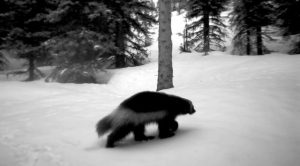The final report summarizes the 3-year sampling effort in the CCoC, which in turn completed a larger 6-year effort over a vast area of the central and southern Canadian Rockies. In 2016, the research team surveyed the last unsampled portion of the Alberta Rockies (south of Kananaskis Country to Highway 3) in addition to a substantial portion of the East Kootenay region of the British Columbia Rockies (BC; >9000 km2). This follow-up effort allowed the team to complete an entire ecoregion-wide wolverine survey in the Canadian Rockies ecoregion, from the US-Canadian border north to Banff and Yoho National Parks. From this data, researchers created density estimates and occupancy models of wolverine distribution and its multiple landscape stressors across an extensive and complex region of the Great Northern Landscape. The report summarizes research findings and makes recommendations regarding management strategies.
 The Canadian Crown of the Continent (CCoC), between Banff National Park and Glacier National Park at the US border, supports an assemblage of carnivores that is unique in North America for its intact diversity. Because of its particular geographic position, the CCoC also represents one of the most strategically important regions in maintaining ecological connectivity for carnivores and other wildlife in the Great Northern Landscape. The CCoC has been identified as crucial for wolverines north of the US border to supply individuals and genes through dispersal to the highly fragmented population in the northern US Rocky Mountains. The Canadian Rockies has been identified as a potential corridor for wolverine movement into the US and the most likely long-term prospect for transboundary wolverine habitat connectivity given climate change scenarios.
The Canadian Crown of the Continent (CCoC), between Banff National Park and Glacier National Park at the US border, supports an assemblage of carnivores that is unique in North America for its intact diversity. Because of its particular geographic position, the CCoC also represents one of the most strategically important regions in maintaining ecological connectivity for carnivores and other wildlife in the Great Northern Landscape. The CCoC has been identified as crucial for wolverines north of the US border to supply individuals and genes through dispersal to the highly fragmented population in the northern US Rocky Mountains. The Canadian Rockies has been identified as a potential corridor for wolverine movement into the US and the most likely long-term prospect for transboundary wolverine habitat connectivity given climate change scenarios.
There is no empirical information on wolverine occupancy, population density, habitat linkages and genetic connectivity in the CCoC region. Coarse-scale models were used to identify core areas and potential connectivity. The lack of empirical, robust demographic and connectivity data to inform management is a growing concern given the increasing scale of landscape impact, and that wolverines are still legally harvested and impacted by two of the three main landscape stressors (land use and climate change) in the Great Northern Landscape.
Remote cameras and noninvasive genetic sampling (NGS) are powerful tools to examine how human disturbance and landscape fragmentation affects species distributions, landscape connectivity, and gene flow. This research will add new sampling to achieve spatial contiguity within the Rocky Mountains and larger transboundary metapopulation shared between the US and Canada. Merging existing data with newly collected data, the research team will create spatially-explicit models of wolverine population size, occupancy, and connectivity.
The objectives of this project are to conduct a survey of wolverine occurrence in the Canadian Crown of the Continent (CCoC) using noninvasive methods; develop occupancy models of wolverine distribution to identify core habitats, dispersal corridors, and highway mitigation; and estimate wolverine density in Canadian Rocky and Columbia Mountains.
PERSONNEL:
REPORTS & DOCUMENTS:
RELATED WORK:
© 2024 Western Transportation Institute – all rights reserved. PO Box 174250, Bozeman, MT 59717